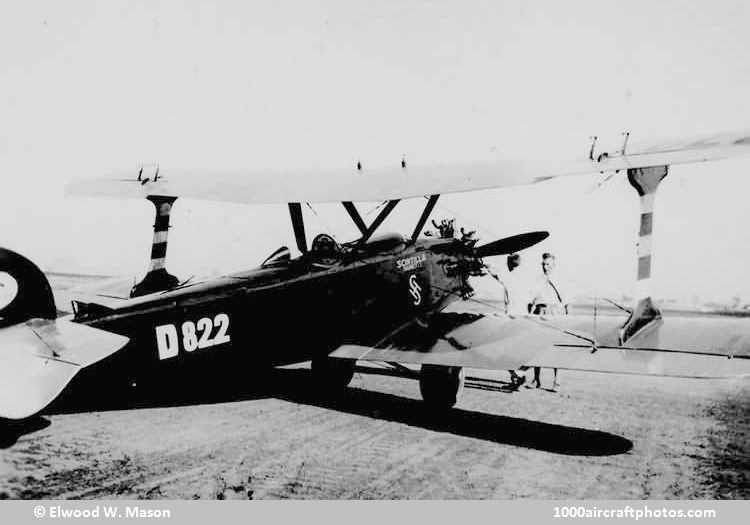11/15/2014. Remarks by Johan Visschedijk: "Udet's own Flamingo, completed at the old Ramersdorf works in early 1926 as an U 12a, was the 'star' performer in every sense. Increasingly, at numerous air displays throughout Germany (and, later, Austria, Switzerland, England and the USA), people flocked to see the breath-taking performance of Udet in his dramatically all-red fuselage and silver-winged Flamingo (a white Flamingo was applied to the left-hand side of the fuselage only. Considering the wide-ranging demands made of D-822 – not least the several 'movie-star' episodes – its lifespan of eight years (1926-1934) is noteworthy.
One of Udet's more flamboyant tests for the Flamingo took place at the Mannheim air display of October 9, 1927. The display organizers arranged an "aerial dual" with Michel Detroyat, also possessing widely-acknowledged skill as a specialist in 'la voltige aérienne', or aerobatics, Flamingos were again in evidence at air shows in 1928 and Udet entered his Siemens & Halske Sh 11-powered U 12a Spezial (Special) for the German aerobatics championships held at Düsseldorf on July 1. Gerhard Fieseler (now best known for his later Fi 156 Storch) was declared the winner, beating Udet into second place while the third position was taken by Willy Stör (also in a Flamingo).
During the winter of 1928-1929, Udet and D-822 were occupied with movie-making at the celebrated Swiss Alpine resort of St. Moritz. The film, regarded as a classic today, is 'The White Hell of Piz Palü'. On March 3, 1929, Udet celebrated the completion of the cine exteriors of 'Peak Palü' by performing his exhibition flying program to a delighted audience of vacationers. This was a typical Udet flourish before putting D-822 into BFW-Augsburg for a complete overhaul. Udet's Flamingo D-822 spent part of the summer of 1929 in a series of publicity flights over several German coastal resorts.
During the period of 1927 to 1929, Udet used D-822 for developing a navel method of aero-towing publicity slogan banners called the Udet-Schlepp-Schrift. For this purpose, D-822 was fitted with a funnel in the front cockpit through which several banners (one below the other) were attached to a ballasted cable. The Udet Schlepp-Schrift did not, however, prove to be successful.
Early in 1930, D-822 was given a more powerful version of the Siemens & Halske series of seven-cylinder radials, the 115/95 hp Sh 14. This brought about a change of designation from U 12a Spezial to U 12b Spezial. During this particular workshop sojourn, improved, bench-type tabs above the ailerons were fitted. Later in the same year, D-822 was again used for filming; this time for the movie 'Storms Over Mont Blanc'.
In the fall or autumn of 1931, Udet literally extended his horizons by accepting his first invitation to show his aerobatic act in America. But before this came about, Udet flew to England for the first time to perform in the display mounted on the occasion of the annual King's Cup Air Race; centered that year (July 25, 1931) on London's Heston Airport.
With his mechanic, Erich Baier, on August 18, 1931, Udet and D-822 were aboard the transatlantic Norddeutscher Lloyd's Europa bound for New York and, in September, the exciting National Air Races at Cleveland, Ohio. For the journey, D-822's fuselage was securely lashed down on the second-class promenade deck while the wings were lodged in the strongroom. At Cleveland, his 'crazy-flying' performances were warmly appreciated.
For the display season of 1932, D-822 was little used because until October, Udet was on yet another filming expedition where he flew his Klemm L 26 a V (D-2269 c/n 378) tandem-seat monoplane. Meanwhile, Flamingo D-822 went in for major overhaul, this time being executed by Gerhard-Fieseler-Werke GmbH of Kassel.
At one time or another, Udet owned half-a-dozen Klemm monoplanes and in 1933 he flew a Klemm L 25 c XI (D-2397 c/n 416) for most purposes, including filming. However, prior to taking his Flamingo to America for the second time, Udet's D-822 had a further engine change, in June 1933, with the installation of a 160/150 hp Sh 14a radial. In July 1933, D-822 and Udet were back in the USA, to give further displays at the air races.
The next film for which D-822 was used had the title of 'Das Wunder des Fliegens' (The Marvel of Flying) which is said to helped to make Germany even more air-minded.
For the 1934 flying display season, Udet still continued to use his familiar mount, D-822, but it was to be for the last time. Ultimately, and with something less than Udet's supreme airmanship (countless thousands had thrilled to his famous 'stunt' of plucking a handkerchief from the ground on the end of a short pole attached to the lower wing tip of the Flamingo), a ferry pilot entrusted with D-822 at Innsbruck, Austria, attempted a return flight to Germany with a spectacular Kavalierstart (climbing take off). Udet's faithful D-822 crashed and was a total write-off.
Besides displaying sponsorship names – publicity for Siemens & Halske and Mobilöl – D-822 carried the letters UDET on each side of the fuselage from early 1926 until March 1930. Then, the fuselage UDETs were replaced by SCINTILLA, (a Swiss-developed ignition system) and UDET was painted on the top wing."
